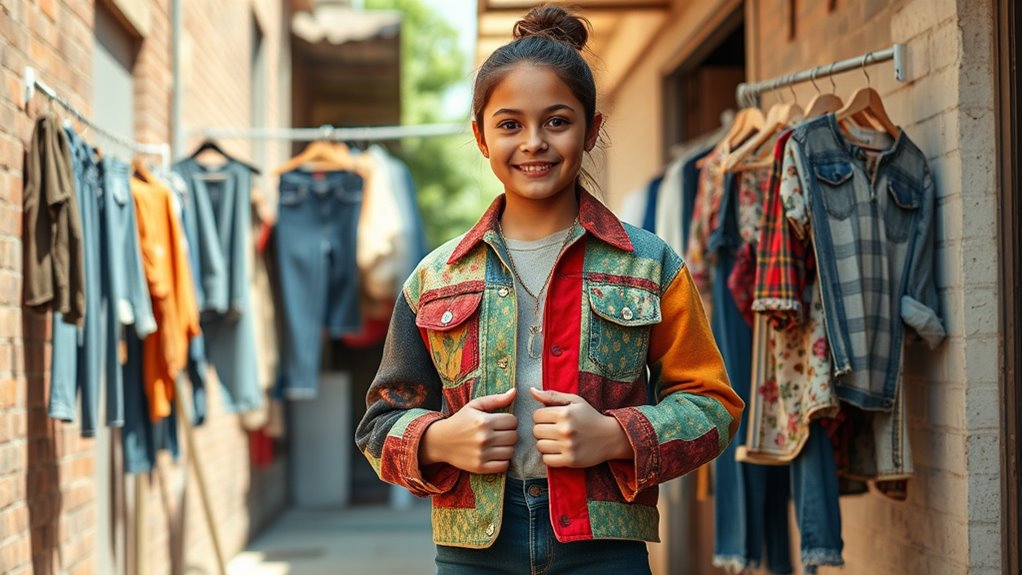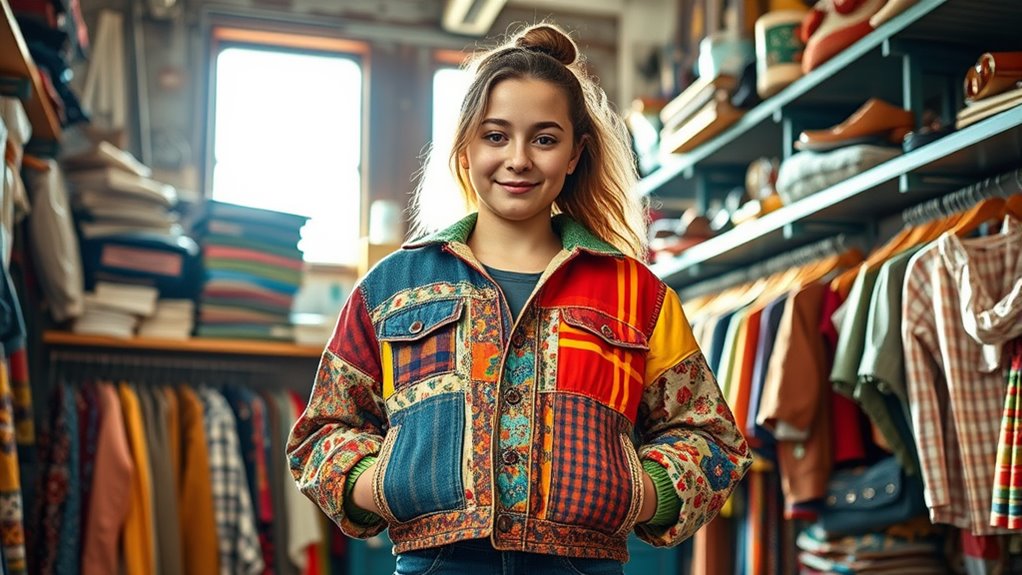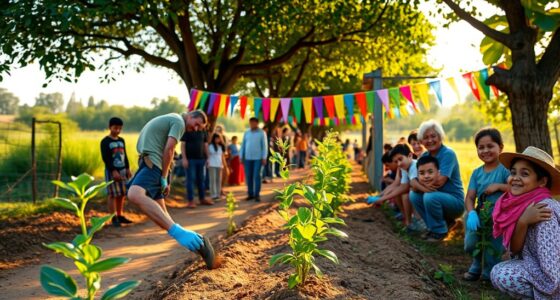You can turn thrift store finds into a trendy fashion line by focusing on unique, versatile pieces that you can easily customize. Use techniques like stitching, dyeing, or patchwork to upcycle clothes and add your personal style. Connecting with community partners and emphasizing sustainability helps showcase your brand’s social impact. Building a collection that blends vintage charm with modern flair sets you apart. Keep exploring these strategies to discover how to transform secondhand clothes into fashionable, meaningful designs.
Key Takeaways
- The teen used thrift shopping to find unique, versatile pieces suitable for customization and trendy styling.
- They transformed secondhand clothes through techniques like stitching, dyeing, and adding embellishments to create fashionable items.
- Personal style and vintage expertise guided the selection and reimagining of thrifted garments into modern designs.
- Collaborations with nonprofits enabled access to donated clothes, supporting social impact and upcycling initiatives.
- Sharing their story and sustainable practices helped position the brand as socially responsible and appealing to conscious consumers.
Finding Inspiration at the Los Angeles LGBT Youth Center

Visiting the Los Angeles LGBT Youth Center opened my eyes to the challenges faced by homeless and marginalized teens, fueling my passion to make a difference through fashion. Seeing young people struggle with acceptance and stability made me realize how clothing influences their self-esteem and sense of identity. I started to believe that fashion could be a powerful tool for empowerment, helping these teens feel valued and seen. I noticed how color accuracy impacts the overall image and confidence of the clothing I create, further inspiring my mission. Understanding the financial impact of youth programs like this has strengthened my commitment to supporting their growth. Witnessing their resilience inspired me to create something meaningful. I adopted the motto “Upcycle, uplift,” committing to transforming secondhand clothes into uplifting fashion statements. My goal became clear: craft designs that not only look good but also boost confidence, giving these teens a reason to feel proud of who they are. Additionally, engaging in remote hackathons has taught me innovative ways to develop sustainable fashion solutions that can reach wider communities and provide more opportunities for youth empowerment. I also learned that personality traits can influence the way I connect with and inspire others in my community.
Learning to Transform Secondhand Clothes Into Fashion Statements

Transforming secondhand clothes into stylish fashion pieces requires both creativity and technical skill. You learn to see potential in worn-out items and turn them into trendy statements. Start by experimenting with basic sewing techniques, then add embellishments like ribbons, patches, or padding to give old pieces new life. Practice repairing stains or tears creatively, transforming flaws into features. Collaborate with nonprofit sources to access diverse materials, expanding your options. You can also explore sustainable fashion principles to reduce waste and promote eco-friendly trends. Additionally, understanding the shelf life of various juices can inspire eco-conscious decisions in your fashion routines. Here’s a quick guide:
| Step | Technique | Result |
|---|---|---|
| Basic Sewing | Stitching, hemming | Fit and structure improvement |
| Embellishment | Ribbons, patches, beading | Unique, eye-catching details |
| Repairs | Patchwork, dyeing | Revived, wearable items |
| Upcycling | Adding new features or layers | Fashion-forward pieces |
Mastering these skills helps you craft standout fashion from secondhand finds.
Building Community Partnerships to Promote Social Impact

Building strong community partnerships is essential for amplifying the social impact of your fashion initiative. When you collaborate with local nonprofits like Project Narnia, you gain access to donated clothes that might otherwise go to waste. These partnerships allow you to serve marginalized groups, such as homeless individuals, by providing them with stylish, upcycled clothing that restores dignity. Engaging with community organizations also helps you understand the specific needs of your target audience, making your efforts more effective. Plus, working together creates a ripple effect—raising awareness, fostering trust, and inspiring others to get involved. By building authentic relationships, you not only expand your reach but also strengthen your mission to create positive social change through fashion. Incorporating sustainable practices into your process further enhances your social impact and appeal. Understanding community needs helps tailor your initiatives to maximize their positive effect on society. Additionally, aligning your efforts with ethical sourcing can reinforce your commitment to responsible fashion. Utilizing collaborative networks can also open doors to new resources and ideas, which can support predictive modeling for better understanding of community trends and needs, amplifying your impact even further.
Positioning a Sustainable, Mission-Driven Fashion Brand

To successfully position a sustainable, mission-driven fashion brand, you need to clearly communicate your core values and social purpose at every touchpoint. This builds trust and loyalty. Focus on these key strategies:
Clearly communicating your mission and values builds trust and loyalty with socially conscious consumers.
- Share your story—explain how your brand’s mission to uplift others and promote sustainability guides every design choice. Sharing self consciousness about your brand’s origins and journey can foster deeper connections with your audience. Emphasizing your commitment to personal growth can inspire consumers and strengthen your brand’s authenticity. Incorporating energy-efficient options in your products and practices demonstrates your dedication to environmental responsibility. Additionally, highlighting your use of vertical storage solutions and other organization techniques can showcase your commitment to sustainable operations and efficient resource use.
- Highlight your impact—show how each piece contributes to social good, like partnering with nonprofits or upcycling materials.
- Use authentic branding—be transparent about sourcing, production, and your environmental commitments.
- Engage your community—invite feedback, showcase customer stories, and create events that reinforce your purpose.
- Leverage trending products—incorporate popular sustainable items such as eco-friendly fabrics to appeal to conscious consumers.
This approach aligns your brand with meaningful values, making it resonate deeply with socially conscious consumers.
Drawing From Vintage Fashion Expertise to Shape a Unique Style

Drawing from vintage fashion expertise allows you to develop a distinctive style that combines history with innovation. By studying past trends and fabric techniques, you can reimagine thrifted pieces into fresh, original designs. Focus on understanding different eras—like the 70s boho or 80s glam—and incorporate those elements into your creations. Experiment with details such as embroidery, appliqué, or fabric mixing to add depth and character. Your knowledge of vintage styles helps you select pieces that have authentic charm and transform them into modern statements. This approach not only elevates your designs but also sets you apart in a crowded market. When you blend history with your creative vision, you craft a unique aesthetic that resonates with both nostalgia and contemporary trends. Additionally, understanding attention in creative practice can inspire innovative ways to incorporate bold, customized details into your fashion pieces, making them truly stand out. Cultivating a keen eye for design details can further refine your ability to create cohesive and compelling collections that reflect your personal style.
Frequently Asked Questions
How Does Upcycling Differ From Traditional Fashion Manufacturing?
You’ll find that upcycling differs from traditional fashion manufacturing because it transforms existing garments into new, unique pieces rather than producing items from raw materials. Instead of mass-producing standardized products, you creatively repurpose and repair clothing, giving it a second life. This process emphasizes sustainability, reduces waste, and often results in one-of-a-kind designs, making it more eco-friendly and personal compared to the large-scale, resource-intensive approach of traditional fashion.
What Challenges Are Faced When Sourcing Thrifted Materials for a Fashion Line?
Sourcing thrifted materials presents persistent problems like limited, unpredictable inventory and inconsistent quality. You might struggle with securing supplies that suit your style, facing fluctuating availability and fabric flaws. Sorting through stacks of donations takes time, and you often encounter stained or damaged pieces needing extra effort. Managing these nuances demands patience, precision, and a passion for repurposing, ensuring your designs stay sustainable, stylish, and one-of-a-kind despite sourcing struggles.
How Do You Balance Creativity With Sustainability in Your Designs?
You balance creativity with sustainability by repurposing and transforming thrifted pieces into unique designs that tell a story. You challenge yourself to innovate with limited materials, adding embellishments or altering shapes to make each item special. By upcycling damaged or outdated clothes, you reduce waste and promote eco-friendly fashion. This approach fuels your passion for creating stylish, meaningful pieces that reflect your values while inspiring others to think sustainably.
What Advice Do You Have for Teens Interested in Starting Thrift-Based Fashion Brands?
Jump in with both feet and start experimenting! You don’t need fancy tools—use online tutorials and your creativity to learn sewing and design techniques. Build partnerships with local nonprofits for materials and support. Stay true to your mission, and don’t be afraid to stand out. Your passion and authenticity will set you apart, and remember, persistence is key—success often comes to those who keep trying even when it’s tough.
How Can Other Communities Replicate Your Social Impact Model?
You can replicate this social impact model by partnering with local nonprofits to source donated clothing, focusing on upcycling to create stylish, uplifting fashion. Engage your community through events and online platforms to raise awareness and foster support. Emphasize a mission of dignity and empowerment, inspiring others to join your cause. Keep sustainability at the core, and prioritize collaborations that maximize reach and positive change within your community.
Conclusion
You’ve seen how turning thrift store finds into trendy fashion can make a real difference. By embracing creativity, building community, and staying true to your mission, you’re proof that style and sustainability go hand in hand. Remember, Rome wasn’t built in a day—and neither is a successful brand. Keep pushing forward, learn from every challenge, and trust that your passion can change the world, one outfit at a time.








